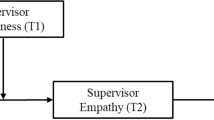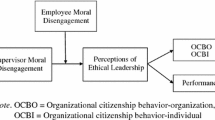Abstract
We report the results of two studies that evaluated the perceptions of supervisor and top leader ethics. In our first study, we re-analyzed data from Pelletier and Bligh (J Bus Ethics 67:359–374, 2006) and found that the Perceptions of Ethical Leadership Scale from that study could be used to differentiate perceptions of supervisor and top leader ethics. In a second study with a different sample, we examined the relationships between (1) individual employees’ perceptions of top managers’ and immediate supervisors’ ethical tendencies, and (2) organizational climate, confidence in top leadership direction, commitment, and citizenship behavior. Results indicated that employee perceptions of top managers’ and supervisors’ ethics were significantly related to climate, top leadership direction, organizational commitment and the OCB dimension, civic virtue.
Similar content being viewed by others
Notes
A shorter, eight-item form is also available. See http://www.sbcraig.com/plis/short.htm.
Data were provided by the first author, Dr. Kathie Pelletier, ‘Rebounding from Corruption: Perceptions of Ethics Program Effectiveness in a Public Sector Organization’, Journal of Business Ethics 67(4), 359–374.
Of the 418 surveys returned, 119 were paper copies, 299 were online responses. As there were two modes of survey administration, t tests were conducted to determine if there was a significant difference between mode of survey administration for the PELS subscale scores. There was a difference (t = 3.17, df = 407, p = 0.002) for the immediate supervisor subscale; those who had returned a paper survey had a lower score (M = 4.68, SD = 1.61) than those who had completed the survey online (M = 5.21, SD = 1.47).
Because of the means of recruitment, response rate was not possible to calculate.
For sample 2, χ2 and Kruskal–Wallis tests revealed there were differences by survey administration method for several demographic characteristics. Respondents to the paper survey were more likely to be women, had shorter tenure, worked in smaller departments and companies, and were more likely to be in wholesale/retail and service industries than respondents from the web-based survey.
This scale was originally used by peers to rate others. We revised the scale for use as a self-report.
References
Allen, N. J., & Meyer, J. P. (1990). The measurement and antecedents of affective, continuance, and normative commitment to the organization. Journal of Occupational Psychology, 63(1), 1–18.
Bass, B. M., & Steidlmeier, P. (1999). Ethics, character, and authentic transformational leadership behavior. Leadership Quarterly, 10(2), 181–217.
Bentler, P. M. (1995). EQS: Structural equations program manual. Encino: Multivariate Software, Inc.
Blau, P. (1964). Exchange and power in social life. New York: Wiley.
Bollen, K. A. (1989). Structural equations with latent variables. New York: Wiley.
Brown, M. E., & Treviño, L. K. (2006). Ethical leadership: A review and future directions. Leadership Quarterly, 17(6), 595–616.
Brown, M. E., Treviño, L. K., & Harrison, D. A. (2005). Ethical leadership: A social learning perspective for construct development and testing. Organizational Behavior and Human Decision Processes, 97(2), 117–134.
Chen, F., Curran, P. J., Bollen, K. A., Kirby, J., & Paxton, P. (2008). An empirical evaluation of the use of fixed cutoff points in RMSEA test statistic in structural equation models. Sociological Methods and Research, 36(4), 462–494.
Clegg, C., Unsworth, K., Epitropaki, O., & Parker, G. (2002). Implicating trust in the innovation process. Journal of Occupational and Organizational Psychology, 75(4), 409–422.
Craig, S. B., & Gustafson, S. B. (1998). Perceived leader integrity scale: An instrument for assessing employee perceptions of leader integrity. Leadership Quarterly, 9(2), 127–145.
Davis, A. L., & Rothstein, H. R. (2006). The effects of the perceived behavioral integrity of managers on employee attitudes: A meta-analysis. Journal of Business Ethics, 67(4), 407–419.
Dirks, K. T., & Ferrin, D. L. (2002). Trust in leadership: Meta-analytic findings and implications for research and practice. Journal of Applied Psychology, 87(4), 611–628.
Ellis, K., & Shockley-Zalabak, P. (2001). Trust in top management and immediate supervisor: The relationship to satisfaction, perceived organizational effectiveness, and information receiving. Communication Quarterly, 49(4), 382–398.
Greller, M. M., & Herold, D. M. (1975). Sources of feedback: A preliminary investigation. Organizational Behavior and Human Performance, 13(2), 244–256.
Griffis, S. E., Goldsby, T. J., & Cooper, M. (2003). Web-based and mail surveys: A comparison of response, data, and cost. Journal of Business Logistics, 24(2), 237–258.
Hays, S. W., & Kearney, R. (2001). Anticipated changes in human resource management: Views from the field. Public Administration Review, 61(5), 585–597.
Hu, L., & Bentler, P. M. (1999). Cutoff criteria for fit indexes in covariance structure analysis: Conventional criteria versus new alternatives. Structural Equation Modeling, 6(1), 1–55.
Ilies, R., Nahrgang, J. J., & Morgeson, F. P. (2007). Leader-member exchange and citizenship behaviors: A meta-analysis. Journal of Applied Psychology, 92(1), 269–277.
James, L. R., Hater, J. J., Gent, M. J., & Bruni, J. R. (1978). Psychological climate: Implications from cognitive social learning theory and interactional psychology. Personnel Psychology, 31(4), 781–813.
Jones, A. P., & James, L. R. (1979). Psychological climate: Dimensions and relationships of individual and aggregated work environment perceptions. Organizational Behavior and Human Performance, 23(2), 201–250.
Koh, H. C., & Boo, E. H. Y. (2001). The link between organizational ethics and job satisfaction: A study of managers in Singapore. Journal of Business Ethics, 29(4), 309–324.
Kottke, J. L., Pelletier, K. L., & Agars, M. D. (accepted for publication). Measuring follower confidence in top leadership direction. Leadership and Organization Development.
Lawler, E. E., Hall, D. T., & Oldham, G. R. (1974). Organizational climate: Relationship to organizational structure, process and performance. Organizational Behavior and Performance, 11, 139–155.
LePine, J. A., Erez, A., & Johnson, D. E. (2002). The nature and dimensionality of organizational citizenship behavior: A critical review and meta-analysis. Journal of Applied Psychology, 87(1), 52–65.
Mathieu, J. E., & Zajac, D. M. (1990). A review and meta-analysis of the antecedents, correlates, and consequences of organizational commitment. Psychological Bulletin, 108(2), 171–194.
McLean, B., & Elkind, P. (2004). The smartest guys in the room: The amazing rise and scandalous fall of Enron. New York: Penguin Group.
Meyer, J. P., & Allen, N. J. (1991). A three-component conceptualization of organizational commitment. Human Resource Management Review, 1(1), 61–89.
Meyer, J. P., & Allen, N. J. (1997). Commitment in the workplace. Thousand Oaks: Sage.
Mize, K. J., Stanforth, N., & Johnson, C. (2000). Perceptions of retail supervisors’ ethical behavior and front-line managers’ organizational commitment. Clothing and Textiles Research Journal, 18, 100–110.
Niehoff, B. P., Enz, C. A., & Grover, R. A. (1990). The impact of top-management actions on employee attitudes and perceptions. Group and Organization Studies, 15(3), 337–352.
Nunnally, J. C., & Bernstein, I. H. (1994). Psychometric theory (3rd ed.). New York: McGraw-Hill, Inc.
Nyberg, D. (2008). The morality of everyday activities: Not the right, but the good thing to do. Journal of Business Ethics, 81, 587–598.
Organ, D. W. (1988). Organizational citizenship behavior: The good soldier syndrome. Lexington: Lexington Books.
Organ, D. W. (1997). Organizational citizenship behavior: It’s construct clean-up time. Human Performance, 10(2), 85–97.
Parker, C. P., Baltes, B. B., Young, S. A., Huff, J. W., Altmann, R. A., Lacost, H. A., et al. (2003). Relationships between psychological climate perceptions and work outcomes: A meta-analytic review. Journal of Organizational Behavior, 24(4), 389–416.
Parry, K. W., & Proctor-Thomson, S. B. (2001). Perceived integrity of transformational leaders in organizational settings. Journal of Business Ethics, 35(2), 75–96.
Patsuris, P. (2002). The corporate scandal sheet. Retrieved September 29, 2011 from http://www.forbes.com/2002/07/25/accountingtracker.html.
Patterson, M. B., West, M. A., Shackleton, V. J., Dawson, J. F., Lawthom, R., Maitlis, S., et al. (2005). Validating the organizational climate measure: Links to managerial practices, productivity and innovation. Journal of Organizational Behavior, 26(4), 379–408.
Pelletier, K. L., & Bligh, M. C. (2006). Rebounding from corruption: Perceptions of ethics program effectiveness in a public sector organization. Journal of Business Ethics, 67(4), 359–374.
Pelletier, K. L., & Kottke, J. L. (2009). Déjà vu all over again: Progress and reversals in battling government corruption. Journal of Leadership, Accountability, and Ethics, 7(3), 78–93.
Podsakoff, P. M., MacKenzie, S. B., Lee, J.-Y., & Podsakoff, N. P. (2003). Common method biases in behavioral research: A critical review of the literature and recommended remedies. Journal of Applied Psychology, 88(5), 879–903.
Podsakoff, P. M., MacKenzie, S. B., Moorman, R. H., & Fetter, R. (1990). Transformational leader behaviors and their effects on followers’ trust in leader, satisfaction, and organizational citizenship behaviors. Leadership Quarterly, 1(2), 107–142.
Revell, J., & Burke, D. (2003). The fires that won’t go out. Fortune, 148(8), 139–142.
Schein, E. H. (1990). Organizational culture. American Psychologist, 45, 109–119.
Schwepker, C. H. (1999). The relationship between ethical conflict, organizational commitment and turnover intentions in the sales force. Journal of Personal Selling and Sales Management, 19(1), 43–49.
Settoon, R. P., Bennett, N., & Liden, R. C. (1996). Social exchange in organizations: Perceived organizational support, leader-member exchange, and employee reciprocity. Journal of Applied Psychology, 81(3), 219–227.
Simons, T. L. (1999). Behavioral integrity as a critical ingredient for transformational leadership. Journal of Organizational Change Management, 12(2), 89–104.
Sims, R. L., & Brinkmann, J. (2002). Leaders as moral role models: The case of John Gutfreund at Salomon brothers. Journal of Business Ethics, 35, 327–339.
Sims, R. L., & Kroeck, K. G. (1994). The influence of ethical fit on employee satisfaction, commitment and turnover. Journal of Business Ethics, 13(12), 939–947.
Spector, P. E. (1987). Method variance as an artifact in self-reported affect and perceptions of work: Myth or significant problem? Journal of Applied Psychology, 72(3), 438–443.
Spector, P. E. (2006). Method variance in organizational research: Truth or urban legend? Organizational Research Methods, 9(2), 221–232.
Steiger, J. H. (1980). Tests for comparing elements of a correlation matrix. Psychological Bulletin, 87(2), 245–251.
Tabachnick, B. G., & Fidell, L. S. (2001). Using multivariate statistics (4th ed.). Boston: Allyn and Bacon.
Therkelsen, D. J., & Fiebich, C. L. (2003). The supervisor: The linchpin of employee relations. Journal of Communication Management, 8(2), 120–129.
Toffler, B. L., & Reingold, J. (2003). Final accounting: Ambition, greed, and the fall of Arthur Andersen. New York: Broadway Books.
Vardi, Y. (2001). The effects of organizational ethical climates on misconduct at work. Journal of Business Ethics, 29(4), 325–337.
Velthouse, B., & Kandogan, Y. (2007). Ethics in practice: What are managers really doing? Journal of Business Ethics, 70(2), 151–163.
Vey, M. A., & Campbell, J. P. (2004). In-role or extra-role organizational citizenship behavior: Which are we measuring? Human Performance, 17(1), 119–135.
Victor, B., & Cullen, J. B. (1988). The organizational bases of ethical work climates. Administrative Science Quarterly, 33(1), 101–125.
Viswesvaran, C., Deshpande, S. P., & Joseph, J. (1998). Job satisfaction as a function of top management support for ethical behavior: A study of Indian managers. Journal of Business Ethics, 17, 365–371.
Vitell, S. J., & Davis, D. L. (1990). The relationship between ethics and job satisfaction: An empirical investigation. Journal of Business Ethics, 9(6), 489–494.
Wiley, C. (1998). Re-examinating perceived ethics issues and ethics roles among employment managers. Journal of Business Ethics, 17(2), 147–161.
Zahra, S. A., Priem, R. L., & Rasheed, A. A. (2007). Understanding the causes and effects of top management fraud. Organizational Dynamics, 36(2), 122–139.
Author information
Authors and Affiliations
Corresponding author
Rights and permissions
About this article
Cite this article
Kottke, J.L., Pelletier, K.L. Measuring and Differentiating Perceptions of Supervisor and Top Leader Ethics. J Bus Ethics 113, 415–428 (2013). https://doi.org/10.1007/s10551-012-1312-8
Received:
Accepted:
Published:
Issue Date:
DOI: https://doi.org/10.1007/s10551-012-1312-8




